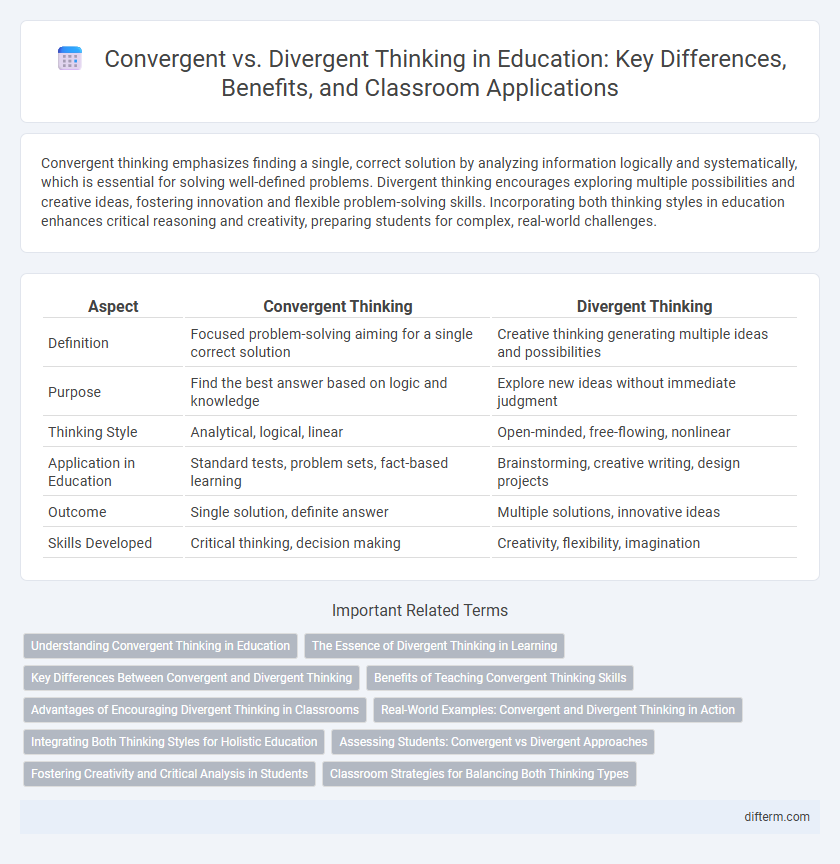Convergent thinking emphasizes finding a single, correct solution by analyzing information logically and systematically, which is essential for solving well-defined problems. Divergent thinking encourages exploring multiple possibilities and creative ideas, fostering innovation and flexible problem-solving skills. Incorporating both thinking styles in education enhances critical reasoning and creativity, preparing students for complex, real-world challenges.
Table of Comparison
| Aspect | Convergent Thinking | Divergent Thinking |
|---|---|---|
| Definition | Focused problem-solving aiming for a single correct solution | Creative thinking generating multiple ideas and possibilities |
| Purpose | Find the best answer based on logic and knowledge | Explore new ideas without immediate judgment |
| Thinking Style | Analytical, logical, linear | Open-minded, free-flowing, nonlinear |
| Application in Education | Standard tests, problem sets, fact-based learning | Brainstorming, creative writing, design projects |
| Outcome | Single solution, definite answer | Multiple solutions, innovative ideas |
| Skills Developed | Critical thinking, decision making | Creativity, flexibility, imagination |
Understanding Convergent Thinking in Education
Convergent thinking in education emphasizes finding the single best solution to a problem, fostering analytical skills and logical reasoning in students. It involves critical evaluation and the application of established knowledge to arrive at concise answers, essential for subjects like mathematics and science. This cognitive approach supports standardized testing and structured learning environments by promoting accuracy and efficiency in problem-solving.
The Essence of Divergent Thinking in Learning
Divergent thinking in learning emphasizes generating multiple creative solutions to a single problem, fostering open-ended exploration and innovation. This cognitive process enhances critical thinking and adaptability by encouraging students to brainstorm diverse ideas without immediate judgment or constraints. Embracing divergent thinking helps develop problem-solving skills crucial for real-world applications and promotes deeper understanding through varied perspectives.
Key Differences Between Convergent and Divergent Thinking
Convergent thinking focuses on finding a single, correct solution to a problem by narrowing down multiple possibilities through logical reasoning and analysis. Divergent thinking encourages generating multiple, creative ideas and exploring various possible solutions without immediate judgment. The key distinction lies in convergent thinking's emphasis on precision and correctness, while divergent thinking prioritizes originality and variety in responses.
Benefits of Teaching Convergent Thinking Skills
Teaching convergent thinking skills enhances students' ability to analyze information critically and arrive at well-defined solutions efficiently. This method fosters precision, logical reasoning, and decision-making, which are essential for problem-solving in STEM disciplines and standardized testing. Developing convergent thinking also improves focus and discipline, enabling learners to synthesize complex data into actionable outcomes.
Advantages of Encouraging Divergent Thinking in Classrooms
Encouraging divergent thinking in classrooms cultivates creativity by enabling students to explore multiple solutions and perspectives, fostering innovative problem-solving skills. This approach enhances critical thinking and adaptability, preparing learners for real-world challenges where flexible, original ideas are crucial. Emphasizing divergent thinking also promotes engagement and motivation, as students feel empowered to express unique thoughts without fearing mistakes.
Real-World Examples: Convergent and Divergent Thinking in Action
Convergent thinking is exemplified in standardized testing environments where students apply logic and knowledge to select the single correct answer, such as solving math problems or answering multiple-choice questions. Divergent thinking manifests in creative projects like brainstorming sessions or open-ended essay writing, encouraging students to generate multiple solutions or perspectives. Real-world applications include engineering design challenges requiring convergent problem-solving alongside marketing campaigns that rely on divergent idea generation.
Integrating Both Thinking Styles for Holistic Education
Integrating convergent and divergent thinking in education fosters a balanced cognitive approach, encouraging students to analyze problems systematically while generating creative solutions. This dual emphasis enhances critical thinking, adaptability, and innovation, essential skills for real-world challenges. Educators who blend both thinking styles create dynamic learning environments that prepare students for complex decision-making and collaborative problem-solving.
Assessing Students: Convergent vs Divergent Approaches
Assessing students using convergent thinking emphasizes evaluating their ability to arrive at a single correct solution, often through standardized tests and objective questioning. Divergent thinking assessments prioritize creativity and multiple possible answers, encouraging students to think broadly and generate original ideas. Combining both approaches provides a balanced evaluation of critical thinking and problem-solving skills essential in education.
Fostering Creativity and Critical Analysis in Students
Convergent thinking emphasizes narrowing down multiple ideas to find a single, correct solution, enhancing students' critical analysis and problem-solving skills. Divergent thinking encourages generating numerous unique ideas, which fosters creativity and innovative thinking. Balancing both approaches in education cultivates well-rounded learners capable of analytical reasoning and imaginative exploration.
Classroom Strategies for Balancing Both Thinking Types
Effective classroom strategies for balancing convergent and divergent thinking include using structured problem-solving tasks that require students to apply logic and arrive at a single solution, while also incorporating open-ended activities that encourage creativity and multiple perspectives. Teachers can alternate between focused, goal-oriented assignments and brainstorming sessions to stimulate both critical analysis and imaginative exploration. Integrating collaborative projects where students evaluate ideas convergently and generate diverse options divergently fosters comprehensive cognitive development.
convergent thinking vs divergent thinking Infographic

 difterm.com
difterm.com